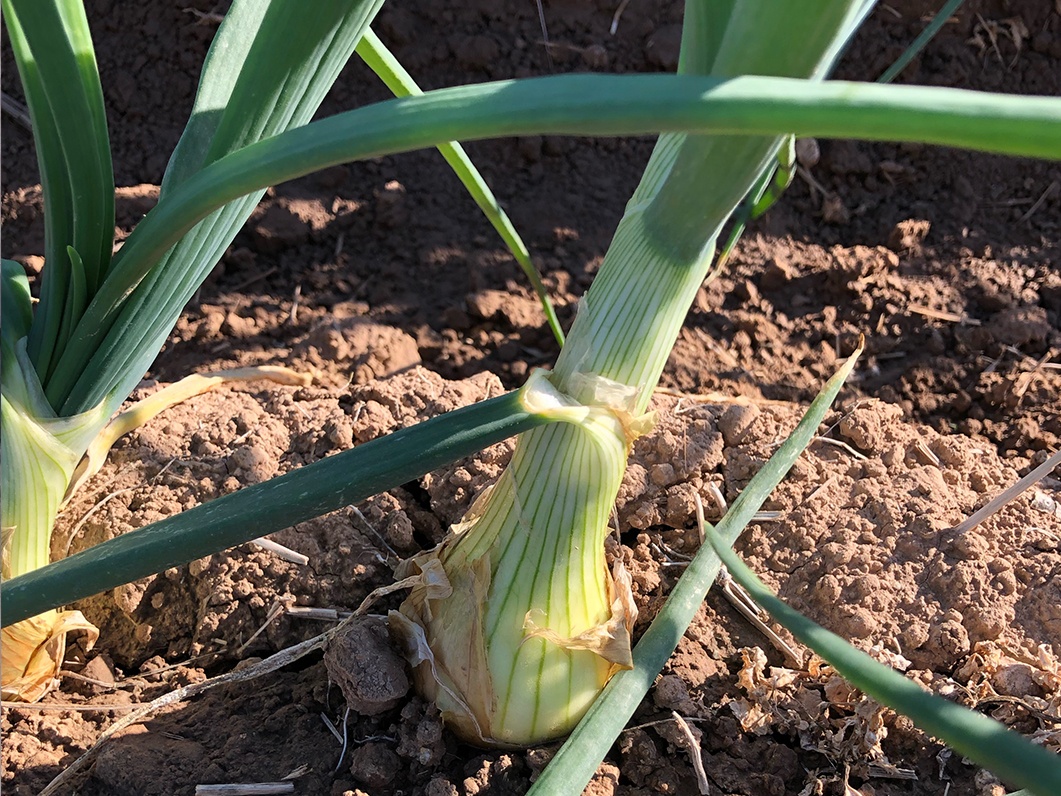Featured image: Brawley, CA crop progress courtesy of John Vlahandreas and Mike Smythe for West Valley Packers
MARKET
Eastern Oregon/Washington:
Jason Pearson with Eagle Eye Produce in Nyssa, OR, told us on Feb. 17 that Eagle Eye has been very busy this week. “Our sales have been very good, and it’s been primarily foodservice, too,” he said. “Maybe people don’t realize how much foodservice has bounced back, but we have a lot of foodservice orders. We have very good demand on yellows, and mostly because of availability this week we are doing primarily mixer loads of reds and whites.” Jason said the market is steady right now, noting, “There’s not one person in the industry that likes seeing another onion region’s crop suffer – ever – but if it turns out that the South Texas crop is damaged due to this freeze, the market is going to go up. That’s just how it works.” Regarding Eagle Eye’s summer program, Jason said, “Currently we have onions in Washington and in Eastern Oregon to take us into mid-April. After that, we’ll be packing out of Brawley, CA, and then out of New Mexico.”
Idaho-E. Oregon/Washington:
John Vlahandreas with Wada Farms reported from his Salem OR, office on Feb. 17. “Demand hasn’t really been too bad this week,” he said. “It is important to note that South Texas isn’t the only place suffering stormy weather. Maybe not as notable, but our area was hit with an ice storm, and some family members have been without power for over a week. Makes communication pretty tough.” He went on to say, “Some onion areas, and in certain parts of the country, some onion production has been delayed along with transportation loading and deliveries being delayed as well. Still, all things considered, onions are moving, just a little slower. Demand and the market for yellows are steady. Reds are creeping up there. When it comes to whites, it’s sort of all over the board. It depends on the quality and the color. I will say that the quality coming out of both Washington and Idaho and Eastern Oregon has been very nice.” John noted that he would be traveling to the desert in California within the next two weeks to assess the Troy Caston crop and will send OnionBusiness.com photos. He expects that program to get started up around April 20.
Idaho/E. Oregon:
Dan Phillips with Central Produce Distributors in Payette, ID, provided his report on Feb. 17. ‘Demand for us has been huge this week,” he said. “Some of it has to do with the fact that nothing is moving down South, and our onions are filling those gaps. On the market side of it, nothing has changed, so it doesn’t necessarily reflect that things aren’t moving out of the South.” He continued, “At this point, one really knows what’s going to happen in South Texas with their crop yet. All that remains to be seen.” On transportation, Dan said, “Weather has made it rough. Trucks can’t get in to load, and loaded trucks can’t make it to their destination. We’ve been waiting on trucks out of Washington to get here to load, and they just can’t make it in. Consequently, they are asking for more on rates, too.” When asked how long Central plans to ship, Dan said, “We always plan to ship until the first or middle part of April, but with all the uncertainty out there, it’s tough to nail it down right now.”
Idaho:
Rick Greener with Greener Produce in Ketchum told us on Feb. 17 that he and his team have been tearing it up for the last several weeks now. “We have been crazy busy,” Rick said. “Mostly retail biz, but loads are going to New York, L.A. and pretty much everywhere in between.” He continued, “We’ve been doing some export business too, sending loads to Panama and Canada.” Rick said that most of the onions “are coming out of the Northwest, with just a few reds out of Michigan yet,” and he added, “Mediums continue to be the hot item due to the Food Box Program, but you know it wouldn’t hurt if they took more jumbos. Taking that many mediums without taking as many jumbos too sort of screws up the deal a bit.” Rick said truck availability has been good, and rates have been OK until this week. “Freight companies are trying to get rates back up there to accommodate the recent storms, so we’ll see how that goes,” he said. “The market has been holding steady. It’s hard to say if the weather down South will have any impact; we’ll just see what happens. Like everyone, we’re watching things down there.”
Utah:
Don Ed Holmes with The Onion House in Weslaco, TX, told us on Feb. 17 that he’s in the final inventory for his Corinne, UT, deal. “We had a really good year,” Don Ed said. “It was good quality all the way through, and just a nice deal.”
Northern Colorado:
John Harris with Paradigm Produce in Fort Morgan said, “The big news so far is not news to many. It’s cold. Everywhere!” He continued, “Demand is clearly being impacted by the cold weather across the country, and it’s certainly causing trouble with the distribution chain as well. I think the biggest question that this cold snap has created is what can we expect from the Texas onion crop?” Noting the freezing temps and the forecast for 80s over the coming weekend, John said, “I’m sure parts of the Rio Grande Valley were colder than others. Some of the crop will make it, but the question then is how much of a seeder problem will we see?” He added, “The effects of this storm will be seen in the coming weeks.”
Mexico:
Don Ed Holmes with The Onion House in Weslaco, TX, said on Feb. 17 that while the Tampico region of Mexico hadn’t suffered from cold weather, it did get heavy rain and some isolated hailstorms. “It’ll take time there to see how it’s going to affect the crop. We’re looking at higher prices. There’s been call for sweet onions. Again, time will tell,” he said. He said by next week The Onion House will have all three colors shipping.
David DeBerry with Southwest Onion Growers in McAllen, TX, told us on Feb. 17 that a hailstorm in Mexico “knocked out some acreage, about 25 to 33 percent.” He said the weather was a “freak event.”
CROP
S. Texas:
Don Ed Holmes with The Onion House in Weslaco said on Feb. 17 the mid-February weekend that brought crippling cold to South Texas is remarkable on all counts. “It was unusually cold, and it was unusually late,” he said. “And about the crop, it takes time to tell what the effect is. Younger onions generally react better to the cold weather, and the fields that are set up to harvest in late March and early April could well grow out of this. We had freezes in 1980 and 1981 that were worse than this, and there were onions that came through it.” He continued, “There’s no doubt we have lost onions, and it could be 25 percent or more. We also don’t know about bolting. Some varieties have had bold resistance bred into the seed, too.” And, Don Ed said, “The bottom line is that we won’t know for a couple of weeks. Onions are more resilient than some other crops, but there’s no doubt it was a devastating freeze.
David DeBerry with Southwest Onion Growers in McAllen said on Feb. 17, “There’s not a word in the English language that covers this.” He said the region was without “all amenities, without cell, electric, internet, water, food, power – it’s all out.” Gas stations that were on backup generators saw lines a mile long of cars waiting for fuel, which David said was some people’s only source of heat and also electricity to charge their communication devices. “In McAllen 90 percent of the homes have had no power in three days, and Dallas hasn’t been above freezing in a week. About the Rio Grande Valley crop, he said, “We’ve never had two freezing nights in a row, and of the four freezes in my lifetime, they all happened in the week between Christmas and New Year. So, we don’t know what’s going to happen because this has never happened before.” He continued, “We’ve got onions that are ready in two weeks and some in two months, and it’s foolish to predict what’s going to happen now when it’s never happened before. We just don’t get freezes in February.” David said both his packers have backup generators, but neither is hard-lined on natural gas. “They have fuel tanks, and those tanks will run out of fuel. Hopefully by the time they do, the power will be restored.” He said, “We have no idea about shipping. But our growers have a lot of experience, and we’ll learn more this coming weekend.”
New Mexico:
James Johnson with Carzalia Valley Produce in Columbus told us on Feb. 17, “Southern New Mexico was spared the brunt of the weather experienced by our colleagues in Texas. Lows here only got to about 16 degrees, which is not at all out of the ordinary. The snow and rains were a slight inconvenience to planting of the spring seeded crop, but overall our area needed it, so we will take it when we can get it. Ten years ago on the first of February our area experienced temps similar to what Texas is seeing, multiple days below freezing and multiple hours below zero. I feel for all these producers as I remember how those cold temps affected our stands and quality.”
California:
Many thanks to John Vlahandreas and Mike Smythe for submitting these recent photos of the West Valley Packers Brawley, CA crop.



